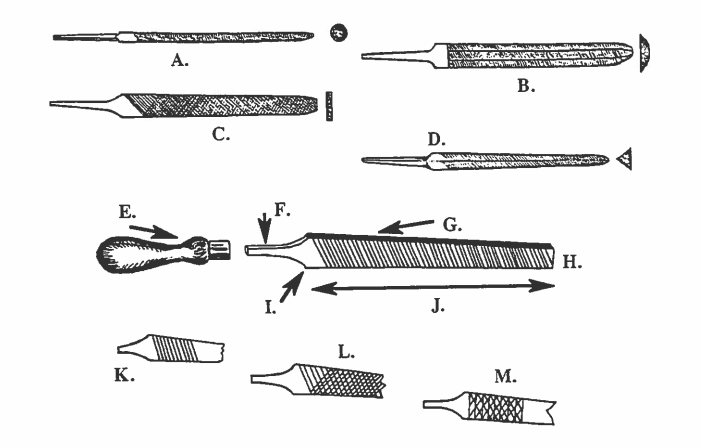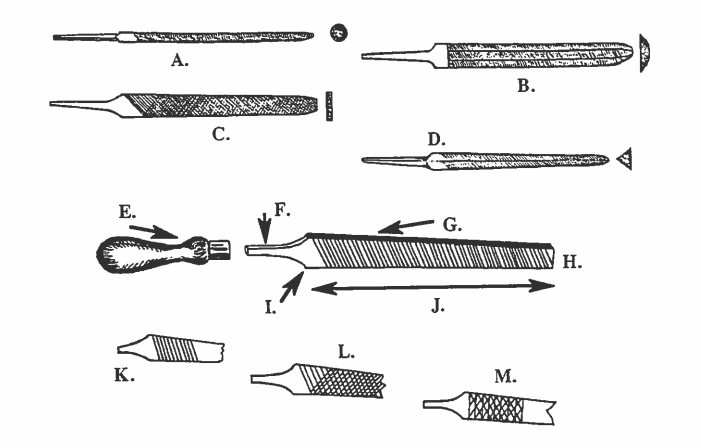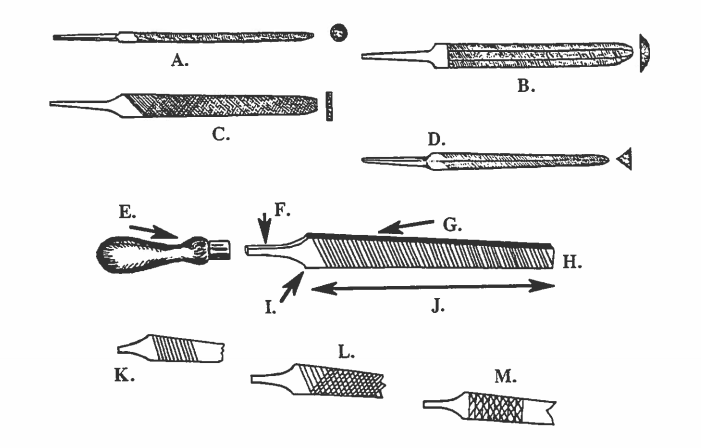Lesson 8: Files
Word List
- coarse – heavy, opposite of fine; smaller number per inch. Example: A coarse file has less teeth per inch than a fine file.
- groove – a continuous slot cut into a surface. Example: The teeth of a file are made by intersecting grooves.
- insert – put into, push into a hole or other opening. Example: Never insert a screwdriver, or any other thing into your ear.
- intersect – two lines or sets of lines cross each other. Example: There is a new street light at the place where the two streets intersect.
- number per inch – how many of something are in an inch of length. Example: A fine-cut file has more teeth per inch than a coarse file.
- passage – the sentences or paragraphs which the reader is reading. Example: Hugo read the passage several times before he was able to understand it.
- pins – are little pieces of metal that get caught in a file’s teeth. Example: Margarita used a wire brush to clean the pins out of the file.
- scan – to look at something quickly hoping to see what you’re looking for. Example: Nancy scanned the Sports Page, looking for score of the game.
- securely – tightly, with no possibility of dropping it. Example: The part was securely held in the jaws of bench vise.
- stroke – a motion which goes a fixed distance, returns, and then repeats the same motion. Example: The file gets pressure only during the forward stroke.
Word Scramble
Reading Technique: SCANNING
Scanning is a reading technique in which the reader knows what he or she is looking for. The reader will not read every word of the passage, but will scan the titles and the paragraphs looking for just the information he/she needs.
Try scanning the passage below, looking for answers to these three questions. (You will answer the questions below.)
- What is the name of the pointed end of the file that fits into the handle?
- What is meant by the words “coarse file”?
- What is the correct way to file a workpiece?
READING
All About Files
The Purpose of Files
Files are hand tools used to remove material and to smooth surfaces. A file can do this because it is made of high-carbon steel and because it has many teeth that cut into the metal.
The Parts of a File
Kinds of Files
There are two kinds of files: (1) single cut, with grooves cut in one direction across the face of the file; and (2) double cut, with one set of grooves cut across the face and a second set that intersects the first to form many cutting teeth.
The sizes of the files and teeth vary from coarse to fine. Coarse-cut files have fewer teeth per inch ; fine-cut have more teeth per inch. Fine cuts can be used on harder metal because they will cut better with their greater number of teeth. There are several shapes for files, including: round, half round, triangular, and flat. A rasp is a heavy file cut in several directions to make big, rough teeth.
The Use of Files
The machinist should make sure that the workpiece is held securely in a bench vise, and that the tang of the file is inserted firmly into a handle. Then the machinist will have two hands free to file correctly.
In one method of filing, the handle of the file is gripped tightly in the right hand. The fingers of the left hand are used to hold the tip of the file. The forward stroke requires pressure to do the cutting. The machinist raises the file for the return stroke, so the cutting edges and teeth will not be damaged. To become skilled at filing, as in everything else, much practice is needed.
Files can get pieces of metal caught between the file teeth: this is called “pinning”. To remove the “pins” from between the teeth a brush is used. Remember to keep your files clean.
Tool Names
Tool Identification

Spelling

Tool Identification and Spelling

Comprehension Questions
End-of-Lesson Questions: Listening
Part A: Look at the pictures. Listen to the tool names words on the recording. Type the letters in the spaces below.
Click here to listen to the recording.

End-of-Lesson Questions: Writing


